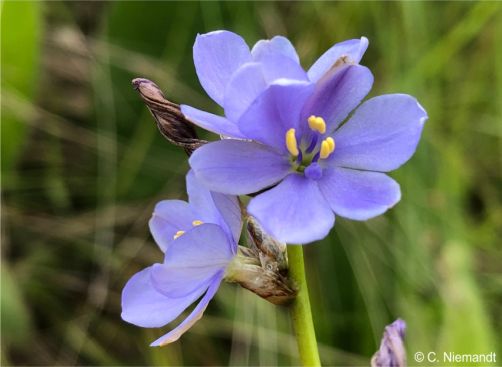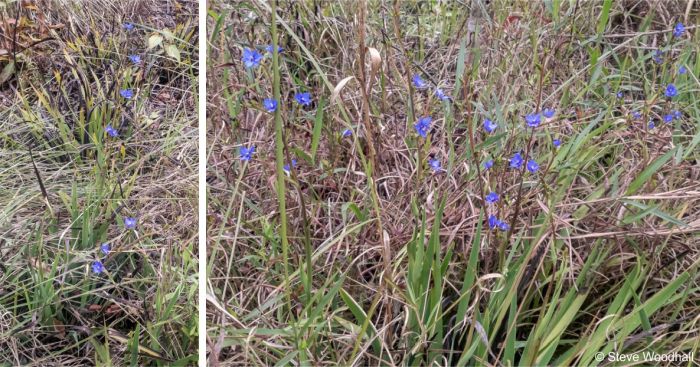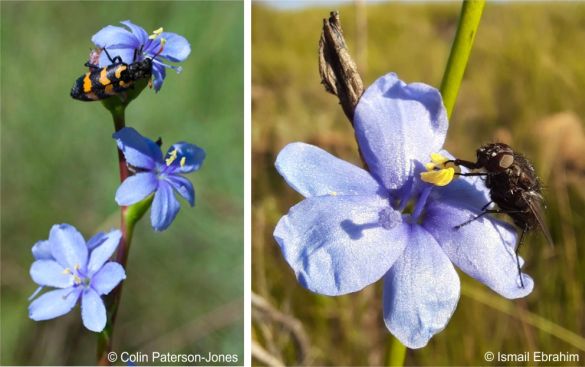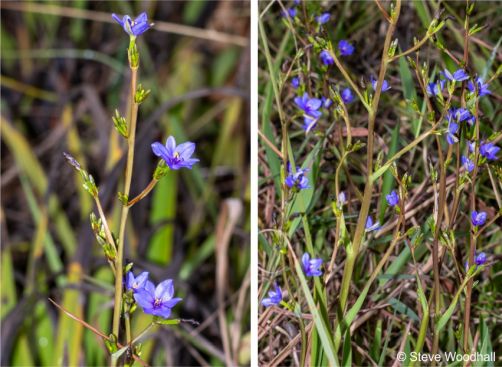Aristea torulosa
Aristea torulosa Klatt (= Aristea woodii N.E.Br.)
Family: Iridaceae
Common names: Wood’s aristea (Eng.); blousuurkanol (Afr.); khahla, lethepu-le-lenyenyane (Sesotho,); umluzi omncane (isiZulu); phayimashimane (siSwati)
Introduction
A lovely, vibrant species of Aristea with striking, star-like, blue flowers that appear prolifically in summer.

Description
Description
Aristea torulosa is an evergreen herbaceous perennial that grows 300–700 mm tall, from a rhizomatous rootstock. Leaves are narrowly lance-shaped or sickle-shaped, or linear, up to ± 450 x 10 mm, with a hard texture, forming a basal fan, the tips and margins are transparent. The stem is simple or with one or two thin branches at the lower nodes of the inflorescence, and with few to several sessile lateral flower clusters in the upper half. The stem is slightly compressed. Most of the leaves are basal, and there are smaller leaves that occur up the stem, known as cauline leaves, occasionally fully sheathing the stem (wrapped around and encircling the stem). Flowers are star-shaped, dark blue to deep mauve, they are borne in several clusters of 4 to 6 flowers up the stem, in midsummer (Dec. to Feb). The flower clusters are often subtended by bract-like spathes that are green at first, becoming brown and membranous as they dry, the edges often becoming torn with age. The fruit is a capsule, dark brown and oblong, ± 8 x 4 mm, containing many angled seeds.

Conservation Status
Status
This species is assessed as Least Concern (LC) in the Red List of South African Plants.
Distribution and habitat
Distribution description
Aristea torulosa is distributed in eastern southern Africa, occurring in South Africa from the Amathole Mountains in the Eastern Cape through KwaZulu-Natal, the eastern Free State, eastern Gauteng and Mpumalanga to Limpopo, and in Lesotho, Eswatini and eastern Zimbabwe. It is found growing in montane or coastal grassland, occasionally in marshy grassland, mostly at elevations between 1 800-2 450 m, but also at lower elevations close to the coast.

Derivation of name and historical aspects
History
The genus name Aristea is derived from the Greek word arista, meaning ‘an awn’ which is a dry bract-like structure with a pointed tip and refers to the dry spathes and bracts in the type species Aristea africana. The species name torulosa means ‘torulose’ or ‘with swellings’, it describes a cylindrical, ellipsoid or terete body that is swollen and constricted at intervals. The reason for the name is unclear.
Aristea belongs in the iris family (Iridaceae), which consists of about 70 genera and ± 2 160 species worldwide, with just over half of them, 36 genera and 1 210 species, occurring in southern Africa. The genus Aristea contains about 58 species that occur from southern Africa, northwards through tropical Africa to Ethiopia and Senegal, and in Madagascar. There are 46 species in southern Africa. The genus Aristea comprises evergreen, rhizomatous perennial flowering plants.

Ecology
Ecology
Aristea torulosa attracts bees, flies and other pollinators to its flowers, and blister beetles feed on the flowers . The habitats occupied by Aristea torulosa are coastal mixed grassland and montane pastures. Species are found growing in moist, sandy, rocky, or loamy soils.
Uses
Use
In the Zulu culture, Aristea torulosa is used as protective charms to repel evil spirits. There are no other records of this species being used in traditional medicine, but it is possible it is used in the same way as Aristea ecklonii, which is used to treat fever, stomach issues, and headaches.
Its striking deep blue to mauve flowers make it a decorative ornamental plant in gardens and landscaping.

Growing Aristea torulosa
Grow
Aristea torulosa is best propagated by seeds, and clumps can be lifted and divided.
Sow seeds in spring, in a well-drained mix of sand and compost, cover the seeds lightly with soil and water regularly. The seeds will germinate in two to three weeks.
To propagate by division, dig up a clump, taking care not to damage the roots, then carefully divide it into separate plants by cutting off the new rhizmomes that have developed from the mother rhizome. Replant them immediately, give them temporary shade and water well for several weeks until they are established. Transplanted or repotted plants can be expected to flower from the third season after transplanting. Plant them in a soil mixture that is well-drained and receives regular watering. Light pruning is required to remove dead and diseased leaves from the plant, and to promote airflow and encourage healthy growth.
Grow Aristea torulosa in full sun or semi-shade, in well-drained, humus-rich soil. Water thoroughly after planting but avoid overwatering as this can result in root rot if the soil is not well-drained. The best season to plant is spring, when temperatures are typically around 20°C.
Aristeas are susceptible to aphids, spider mites and caterpillars. For treatment, apply organic insecticidal soap on the plant. The common diseases that attack them are leaf spot and crown rot this can be treated or managed by removing the affected parts of the plants to encourage airflow and new growth.
References
- Brickell, C. 2007. The Royal Horticultural Society Encyclopedia of Gardening. Dorling Kindersley.
- Duncan, G. 2010. Grow bulbs. Kirstenbosch Gardening Series. South African National Biodiversity Institute, Cape Town.
- Ebrahim, I. 2023-Jan. Observation of Aristea torulosa, Maloti-Drakensberg, KZN. iNaturalist. Online. https://www.inaturalist.org/observations/191168000.
- Goldblatt, P. & Manning, J.C. 2020. Iridaceae of southern Africa. Strelitzia 42. South African National Biodiversity Institute, Pretoria.
- Iziko Biodiversity Explorer. Aristea torulosa. https://www.biodiversityexplorer.info/plants/iridaceae/aristea_torulosa.htm. Accessed on 2024/10/20.
- Louw, S. 2022-11. Observation of Aristea torulosa, Entumeni Nature Reserve, KZN. iNaturalist. Online. https://www.inaturalist.org/observations/143204892.
- Niemandt, C. 2023-Dec. Observation of Aristea torulosa, Nkangala District, Mpumalanga. iNaturalist. Online. https://www.inaturalist.org/observations/232870395.
- Nzuza, P.P. 2021. Aristea torulosa Klatt. National Assessment: Red List of South African Plants. Accessed on 2024/10/20.
- Pooley, E. 2003. Mountain flowers, a field guide to the flora of the Drakensberg and Lesotho. Natal Flora Publications Trust, Durban.
- Pooley, E. 1998. A field guide to wild flowers of Kwazulu-Natal and the eastern region. Natal Flora Publications Trust, Durban.
- Waterberg BioQuest. Aristea torulosa. http://www.waterberg-bioquest.co.za/Flower%20spp%20pgs/ari_toru.html. Accessed on 2024/10/20.
- Woodhall, S. 2024-Sep. Observation of Aristea torulosa, eThekwini, KZN. iNaturalist. Online. https://www.inaturalist.org/observations/240311235.
- Zondi, S. 2013. Aristea ecklonii Baker (Iridaceae). PlantZAfrica. Online. https://pza.sanbi.org/aristea-ecklonii.
Credits
Ofentse Naanyane and Lesego Tlhatlhelang
Free State National Botanical Garden
November 2024
Acknowledgements: the authors thank Steve Wood, Ismael Ebrahim, Sharon Louw and C. Niemandt for making their pictures available on iNaturalist, and the estate of the late Colin Paterson-Jones for allowing the use of his image on Iziko Biodiversity Explorer.
Plant Attributes:
Plant Type: Bulb
SA Distribution: Eastern Cape, Free State, Gauteng, KwaZulu-Natal, Limpopo, Mpumalanga
Soil type: Sandy, Loam
Flowering season: Early Summer, Late Summer
PH: Acid, Neutral
Flower colour: Blue
Aspect: Full Sun
Gardening skill: Average
Special Features:
Horticultural zones









Rate this article
Article well written and informative
Rate this plant
Is this an interesting plant?
Login to add your Comment
Back to topNot registered yet? Click here to register.